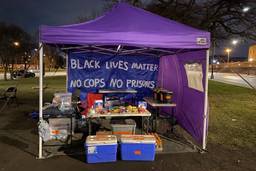Suicide by Appointment
A soldier’s story of living precariously with PTSD. And of a government unable to help him.
Richard Baker

In 1966 and 1967, I served in Vietnam as a point man for the 4th Infantry Division outside Pleiku. Since then I have been hospitalized in Veterans Administration (VA) psychiatric institutions for suicidal depression two times — once about four years ago after I tried to bleed out by cutting off my hand. I call PTSD an injury, not an illness, because it is an injury to the brain, to your emotional and psychological well-being.
The current practice is to treat the injury, not prevent it. Preventing PTSD would be simple: Don’t send people to war. Treating the injury is more difficult, and currently, the VA’s efforts are a failure.
According to the Department of Veterans Affairs, each day 22 soldiers from America’s present wars in Iraq and Afghanistan commit suicide. There are no such statistics for Vietnam veterans, although estimates from prominent doctors and organizations range from tens of thousands to hundreds of thousands.
After the attempted amputation, I started traveling to Vietnam as therapy, at the suggestion of a VA psychologist. The VA has found that returning to the scene of the crime offers some benefit. And it does, at least for me. I remember the devastation of war, the time I cradled a young North Vietnamese Army soldier in my arms trying desperately to hold him together as he died. I vowed to never injure another creature. I cannot shake that image, or many other images and emotions. Traveling to Vietnam shows that the country has moved on. The people are extremely pleasant and hold no animosity towards us. With an average age of just 28, most Vietnamese do not even remember the war. It helps so much that I visit often and even write for a Vietnamese magazine in Hanoi called Vietnam Cultural Window. There are, however, risks involved: The smallest of incidents — seeing a kid in a village, eating a certain kind of food or encountering certain smells, like diesel — can cause flashbacks that place me back into the war leaving me short of breath, depressed and often bundled on the floor or leaning against the wall and sobbing uncontrollably. I am overwhelmed with the guilt of injuring people whose only crime was wanting the freedom to have their own country.
Veterans with PTSD are assigned to a special “team” at the VA for routine medical care, where doctors are aware of potential suicide risk and trained to recognize it.
During my last trip to Vietnam, in October 2012, something triggered my depression. I am much more fortunate than soldiers new to the injury. Usually, if I know the trigger I simply continue with my life; but this time I could not figure it out. That is when things get dangerous.
This time, the depression was so profound that during a scheduled VA medical appointment, the doctor noticed my depression immediately and asked if I wanted to spend a few days in the hospital, for my own safety. Out of arrogance, and pride, I declined.
For a suicidal soldier, agreeing to internment in a VA psychiatric facility is a bit unnerving. You are placed under suicide watch on a bed in the center of a room. A single light bulb stares down at you from above, and a worker sits nearby and eyes you all night after telling you to relax and get some sleep.
Soldiers are often treated like children in VA psychiatric facilities. Although the healthcare workers mean well, the patients are required to talk about their feelings, mingle with other soldiers and play games, like bouncing around a beach ball without letting it hit the floor. What some people often need instead is a quiet place to go for a few days, where the company of people is available, but where they are not required to mingle. They need a chance to rest, to read a book and to sort out events.
Worried about me, the doctor informed the psychiatric unit of my emotional state, and later that afternoon, my wife told me someone from the mental health clinic had called and would call back later that afternoon. I was grateful for the concern because I was sinking even deeper into depression, so deep that I could not help myself. Thankfully my son, seeing the state I was in, had taken my pistol under the pretext he wanted to do some target practice. (He always gets this urge to go shooting when I am having difficulty.) I waited around that afternoon but the return call never came.
By the next day, I was creeping close to the edge: I could not shake the nightmares and the flashbacks to the jungle and cradling that young man. Dying seemed preferable to living, which is what suicide is all about. I finally called the VA to explain my situation and to make an appointment with the mental health clinic. The conversation went like this:
Me: I feel very suicidal and would like to make an appointment to see a doctor.
VA: I’m sorry, we can’t make an appointment for you.
Me: I have a very serious case of PTSD. I have been seeing doctors for 40 years. All I need is an appointment.
VA: Our policy has changed. Before you can get an appointment you must come in and be evaluated for suicide.
Me: How do I do that?
VA: Go to Building 61 and tell them that you are suicidal. Someone will see you and decide if you can get an appointment.
Me: OK. I will go out there now.
VA: I’m sorry, you can’t go now. It’s Friday, too late in the day, and they usually leave early. You’ll never get there in time.
Me: You don’t get it. I’m suicidal now. I need to see someone.
VA: You’ll just have to put that off until Monday.
Me: So I can’t kill myself until Monday?
VA: If you wait until Monday, maybe we can help. Just don’t show up between noon and one. Everyone is at lunch.
I put down the phone and started to laugh. The VA had unwittingly helped me by making everything so absurd. But I hate to think of some troubled Iraq or Afghanistan veteran attempting to get help from the VA.
I survived until Monday, when I went to Building 61 to get an appointment. I explained my situation to the receptionist and within minutes a nice lady took me to her office for a talk. She was very kind and understanding and patronizing. She took some notes and asked me to return the following day.
The next day I returned, as instructed. The woman asked what I wanted. I reminded her that I was just there the day before. She did not remember me. I smiled, and left.
A day or two later I finally realized what had triggered my suicidal bout. It was something simple, the memory of a Vietnamese soldier on maneuvers crouched on a hillside outside Dien Bien Phu in the highlands of Vietnam, holding his AK-47.
I remembered his innocent and serious eyes, like the eyes of so many other North Vietnamese Army soldiers I have seen, mostly prisoners, or dead and staring at some lost future.
With that recognition I was able to continue with my life until the next incident.







